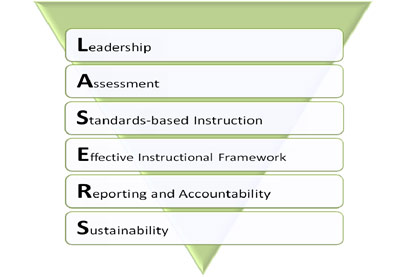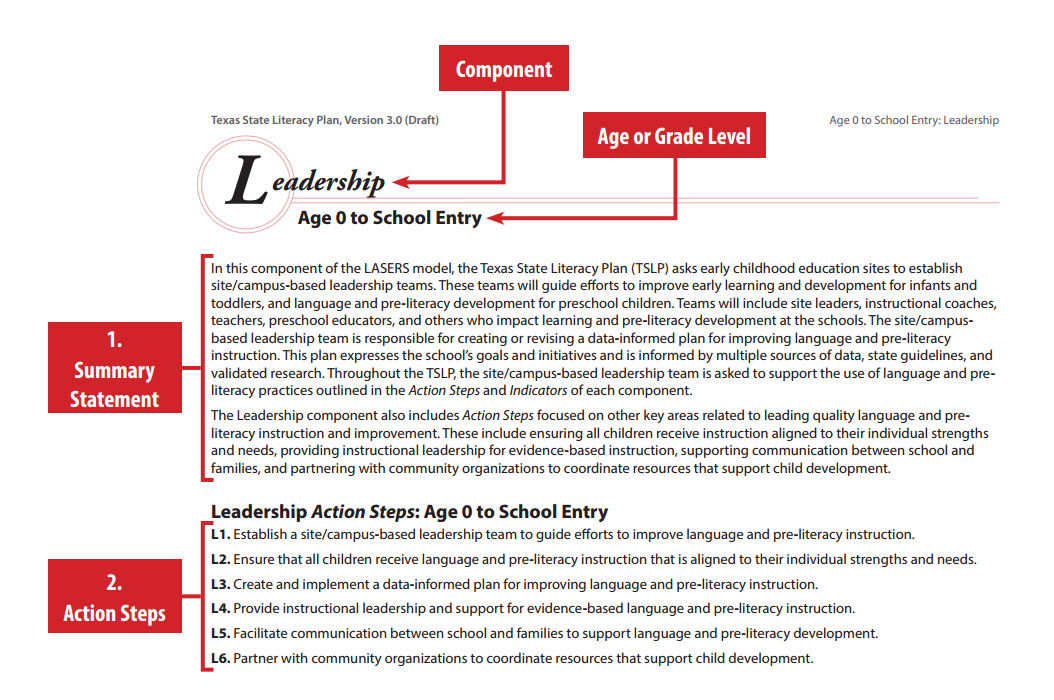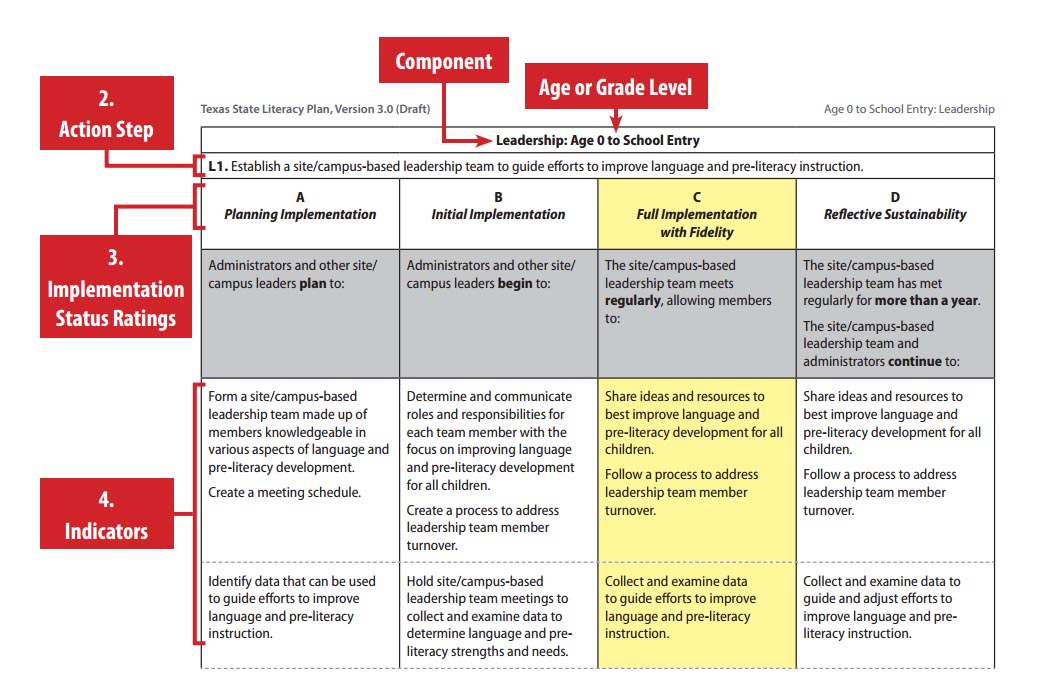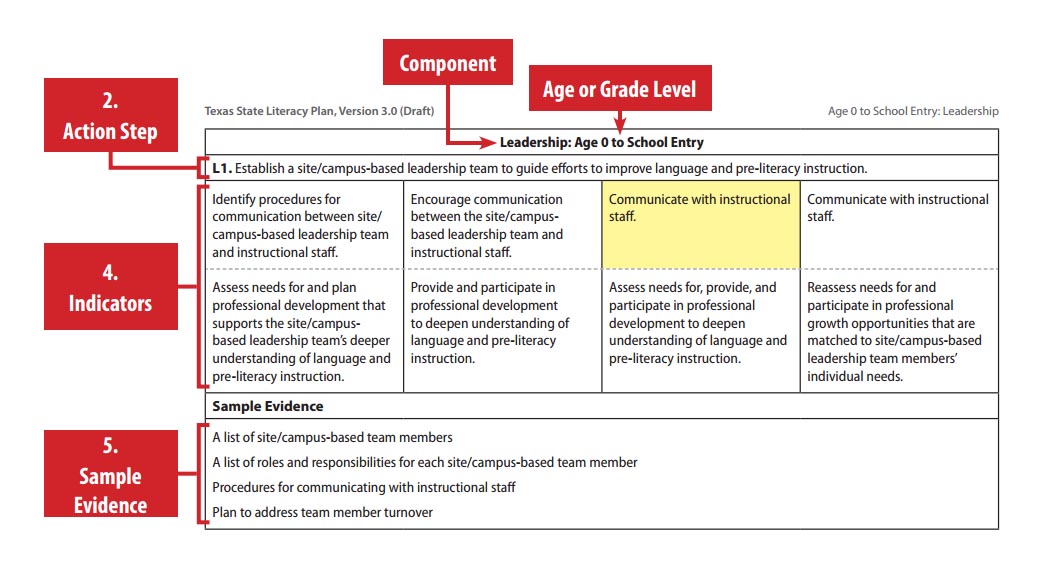The TSLP online course can be used by schools in various ways. Two main ways that it may serve your school or district are
-
for building capacity of leaders at the site and campus level.
-
for guiding improvement efforts—supporting the prioritizing of focus areas, as well as information and resources specific to priorities once they are identified.
First let’s look at using the course for building capacity. By engaging in the online course, school leaders can learn about evidence-based practices for literacy instruction, response to intervention (RTI), and assessment. They can also learn about planning, leading, evaluating and sustaining improvement efforts.
When using the course for building capacity, schools may decide to begin with the Leadership module. This module guides you in building your site- and campus-based leadership teams, which are an integral element of the TSLP. From there, these teams may engage with the modules in the order of the LASERS components or in order of priority based on their self-assessment of TSLP Implementation (explained in detail in the Introduction lesson). For example, a school may identify the Standards-based Instruction component as an area of need and decide to proceed to this module right after participating in the Leadership module.
Schools may also decide to engage in the modules out of order for other strategic reasons. For example, a school may decide to participate in the brief Sustainability module at the beginning of a limited-time initiative to help them create an action plan that will be successful and enduring, that is, to build in sustainability from the start.
Leaders would benefit from previewing the components of the TSLP and sampling some lessons to decide which approach will best meet the needs of their district or school. In any configuration, it is highly recommended that leadership team members begin the course with the Leadership module, especially Lessons 1–4.
In addition to the five LASERS component modules, you will find an Implementation module, which guides participants in the process of planning, enacting, and evaluating their focused work on an Action Step. The examples in the module show a campus team working on an Action Step from the Effective Instructional Framework component. However, the process described in the module is useful when implementing an Action Step from any component of the TSLP, so the module can be used multiple times, with different areas of focus. Schools might decide to engage with several LASERS modules to build knowledge and then take the Implementation module, or alternate between LASERS modules and the Implementation module.
The TSLP online course can also be used as a point-of-need professional development tool. Using this approach, schools identify their areas of priority with regard to the TSLP and then engage with the module that corresponds to that area. For example, if a school’s self-assessment shows a strong need in the Assessment (A) area of LASERS, the team could follow their Leadership (L) module with the A module. Once team members have strengthened their capacity in that area of need, they might then use the Implementation module to guide their work on a particular Action Step in that component.
To be best prepared to use the TSLP online course successfully, it is recommended that all participants review the Introduction lesson and the Leadership module, at least Lessons 1–3.
Regardless of what starting point or approach to the course you use, it is important to remember that the conversations and learning that come from engaging with the course content may enable teams to see new gaps and needs, leading them to change priorities and adjust action plans when appropriate.
The following scenario shows how one elementary school initiates literacy improvement efforts using the TSLP and its supporting resources, including the TSLP online course.
Scenario: Administrators at Sotomayor Elementary School have among their goals the top priority of improving the delivery of literacy instruction for English learners (ELs) at their campus. Knowing that they will begin work implementing the TSLP in the coming school year, they decide to align their TSLP efforts with this top priority. The principal, instructional administrator, and the campus reading coach decide that the initial step in achieving this goal is to build a campus-based leadership team, which will lead the school’s efforts in the areas of literacy and response to intervention (RTI) for ELs. So, they begin with the Leadership module of the TSLP online course, which guides them in building a strong campus-based leadership team.
Once the campus-based leadership team is formed, its first task is to collaboratively review key student data and identify overall trends in literacy development, with focused attention on the campus’s EL population. At the end of this initial data analysis meeting, the team leader assigns “homework” for members to complete before the next meeting. She asks team members to review the different components of the TSLP with their Action Steps and Indicators, to skim the related lessons in the TSLP online course, and to bring ideas about what lessons and components should be prioritized, based on each member’s expertise and knowledge of the staff’s areas of need. At the next meeting, the team considers these contributions and ideas, along with another key source of information: the school’s self-assessment and Implementation Inventory.
After engaging in thoughtful review of each of these sources of information, the team agrees that most staff either do not have a clear understanding of RTI or misunderstand RTI as a process that only certain specialized staff need to be knowledgeable about. Team members feel that they need to garner a strong foundational knowledge of RTI and be able to better assess the campus’s current RTI model, as well as pinpoint Action Steps needed to ensure a strong RTI foundation is in place. Team members agree that focusing on the Effective Instructional Framework (E) component of the TSLP will help them to address these areas of need.
The team sets a schedule for reviewing the content of the E module of the TSLP online course, meeting to discuss the content, and completing the assignments. As they take the module, team members discuss which Action Steps are potential priorities and stay flexible about what path to take after completing the E module.
For example, one possible path the team could take is to participate in the Implementation module right after the E module. That way, the team would begin focused work on implementing change related to a specific Action Step they learned about. On the other hand, their discussion of RTI might lead them to realize that there are major areas of need in the area of assessment. In this case, the team might decide to complete lessons in the Assessment module before beginning the Implementation module or implementing a specific Action Step.




